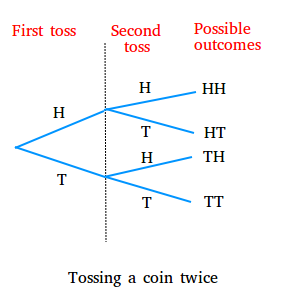Possible outcomes
Possible outcomes are the possible results of an experiment. For example, when you flip a coin, the coin could land on heads or the coin could land on tails.
The possible outcomes of flipping a coin once are heads or tails.
More examples showing the possible outcomes of an experiment
Flip a coin twice:
Let heads = H and let tails = T
If you flip a coin twice, there are four possible outcomes: HH, HT, TH, or TT. Here is a tree diagram showing this experiment.

Roll a die:
If you roll a die once, there are six possible outcomes: 1,2,3,4,5, or 6.
Rolling a die twice:
If you roll a die twice, there are 36 possible outcomes:
(1,1), (1,2), (1,3), (1,4), (1,5), (1,6)
(2,1), (2,2), (2,3), (2,4), (2,5), (2,6)
(3,1), (3,2), (3,3), (3,4), (3,5), (3,6)
(4,1), (4,2), (4,3), (4,4), (4,5), (4,6)
(5,1), (5,2), (5,3), (5,4), (5,5), (5,6)
(6,1), (6,2), (6,3), (6,4), (6,5), or (6,6)
Notice that the possible outcomes are the same if you roll a die twice or roll two dice once.
Take a test:
If you take a test, there are two possible outcomes: Pass or Fail